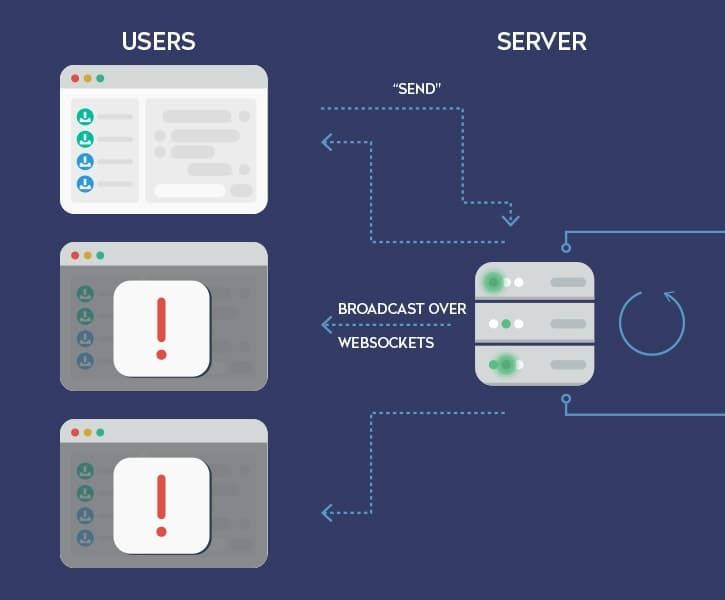In today’s highly competitive market, enterprises must invest in web app development that is swift, secure, and adaptable to evolving business needs.
A well-built enterprise application ensures smooth operations, enhances decision-making, and supports real-time intelligence—key factors for business growth.
Mobility remains a top priority, allowing businesses to stay connected across platforms. Along with this, enterprises seek scalable and high-performing solutions that can handle increasing user demands without compromising speed or security.
For years, Node.js has proven to be a powerful platform for enterprise web app development. It efficiently addresses these needs, offering high-speed execution, real-time capabilities, and a strong developer community. Its rapid adoption among enterprises highlights its reliability.
Before diving into its benefits and why businesses are increasingly choosing Node.js, let’s first understand what Node.js is and how it functions.
What is Node.js?
According to Wikipedia “Node.js is an open-source, cross-platform, JavaScript, run-time environment that executes JavaScript code outside of a browser.
Node.js lets developers use JavaScript to write command line tools and for server-side scripting—running scripts server-side to produce dynamic web page content before the page is sent to the user’s web browser.
Consequently, Node.js represents a “JavaScript everywhere” paradigm, unifying web application development around a single programming language, rather than different languages for server- and client-side scripts”.
In simple words, Node.js shines by applying the push technology over websockets in the real-time web applications. But what’s so special about it?
It’s special because it has transformed an age-old standard which was based on a stateless web & request-response.
With Node.js we’ve finally entered into the realm of real-time web applications with two-way connections, where server and client both can start the communication by exchanging the data freely.
This used to be totally different earlier, when only the client had the permission to initiate the communication.
Node.js was first unveiled in 2009 at the annual European JSConf by Ryan Dahl. Initially, Node.js was sponsored as an open-source project by a hosting solutions and cloud computing provider Joyent.
This company has already invested in several technologies like Ruby on Rails framework and had also provided hosting services to LinkedIn and Twitter.
Moreover, LinkedIn also became the first company to use Node.js technology for the backend development of its mobile application.
Later on, many other companies like Netflix, Walmart, eBay, Uber, and many more adopted Node.js.
How Node.js architecture works?
Node JS is based on an event-driven architecture. The two features that make Node’s performance noteworthy are its non-blocking nature for every I/O along with the fact that it’s asynchronous. These features also enhance its scalability for developing large-scale enterprise web applications that consist of massive volumes of transaction operations (input/output).
Apart from the enterprise solutions, Node also scales web apps and games effortlessly, which involve real-time communication. This makes it a preferred choice for developers working on projects that require high performance. If you're considering utilizing Node.js for your next project, you may want to hire Node.js developers to take full advantage of its capabilities.
Let’s take an example of a restaurant to understand the non-blocking and asynchronous nature of Node.js. In a restaurant, there are multiple tables where people sit and order. Once the order is placed, the waiter notes it down and informs the chef to prepare the order.

A waiter takes multiple orders at once while the chef is still preparing the first order. Here, the waiter doesn’t have to wait for the chef to finish the preparation of the first order before serving other tables.
The working of Node.js is also quite similar. The thread allocated to manage a request can handle multiple requests at a time like a waiter. We can use the same restaurant example to understand synchronous and blocking nature.
In this, the waiter takes the order from one table and then waits in the kitchen until it’s prepared. During the preparation of the meal, the waiter could not take any other orders.

In such cases, you would need one thread for each request. This means that, if the number of requests is massive, then you may run out of threads. Such scenarios highlight the counter-productivity of synchronous and blocking nature.
Because of those additional requests, you will have to wait as multiple threads are rendered inoperative. To build efficient, scalable systems that avoid such bottlenecks, it’s important to hire web developers with expertise in asynchronous technologies like Node.js.
This is exactly how synchronous and blocking technologies like Ruby on Rails and ASP.net work.
However, enterprises that prefer Ruby on Rails can still build efficient applications, especially if they hire Ruby on Rails developers with expertise in optimizing performance.
What is Node.js used for?
Node.jS is built on Chrome’s V8 JavaScript engine. It’s an asynchronous event-driven JavaScript runtime. It uses the non-blocking/event-callback approach, it offers a single-threaded event-io model which enables orchestration of all the tasks that are running in parallel.
Moreover, it doesn’t require a large memory footprint to support multiple connections. Application of Node.js goes beyond than just web application development. It can be also used for:
- Frontends
- Backend and servers
- API development
- Microservices
- Automation and scripting
Now that we understood what Node.js is used for, let’s see when you should and shouldn’t use Node.js.

Where Node.js should be used?
Chat
Chat applications serve as one of the best examples of Node.js. It’s a data-intensive, lightweight, high traffic application that operates across devices. It’s also an ideal use case for learning because it’s simple and covers most of the aspects and paradigms that you might not use typically in Node.js application.
Now, let’s understand how it works.
Let’s take an example of a single chatroom on the website where users exchange messages to each other. For example, we assume that three people are connected to each other on the message board. On the server-side, the Express.js application implements two things which are:
GET /request handler which serves the webpage has both the ‘Send’ button and message board message input initiation.- A WebSockets server that listens to every new message that has been emitted by the WebSocket clients.
So, we have an HTML page that consists of two handlers set up, one of them is for the ‘Send’ button click event whose role is to pick up input message and then send it to the WebSocket. While the other one listens for the new upcoming messages on the WebSockets client.
This is what happens when one of the clients posts a message:
- The browser receives the ‘Send’ button click via a JavaScript handler. It picks up the value from the input field and then sends it to the WebSocket message by using WebSocket client which is connected to the server.
- After this, the WebSocket connection on the server-side component receives the message and forwards it to every other connected client by using the broadcast method.
- Now, all the clients receive the new message in the form of the push message through the client-side component of WebSockets that is running within the webpage. After this, they simply pick up the message content and then update the web page by affixing the latest message on the board.

This was the most basic and simplest example. You can also use a simple cache that is based on Redis store for a more robust solution.
API on top of an Object DB
Apart from real-time applications, Node.js also works well for exposing data from the object DBs. JSON stored data enables Node.js to work without data conversion and impedance mismatch. For example, if you’re using Rails, you would require to convert it from JSON to binary models.
Only after then you can expose them back as the JSON over HTTP when the data is consumed by AngularJS, Backbone.js, etc. Node.js allows you to expose your JSON objects along with REST API for your clients to consume.
Moreover, you don’t need to take stress about converting JSON while writing or reading from your database. The bottom line is that you use uniform data serialization format for server-client, and database to simply avoid the need for multiple conversions.
Data streaming
In traditional web platforms, the HTTP responses and requests are treated as individual events. In a more real sense, they are actually streams. This can be used to develop some really awesome features. For example, you can process the files while they are being uploaded.
This is because the data comes in via a stream which enables us to process it in an online manner. This is can be achieved for real-time video and audio encoding. This can be also done for proxying between various data sources.
Node.js frameworks and their types
Each web-app technology comes with various kinds of frameworks that support a specific use case in the development lifecycle. If we look at Node.js then it comes with three types of frameworks which are:
MVC framework
MVC framework is known for splitting application logic into three parts viz. views, models, and controllers. This splitting also helps in separating development concerns which result in easy scaling and maintenance of the app. Example of an MVC framework is Express.js.
Full-stack MVC frameworks
These types of frameworks are used for real-time applications as they offer a wide array of libraries, scaffolding, template engines, and other developing capabilities. Moreover, it can take care of backend as well as the frontend development of applications.
REST API frameworks
This framework has a reputation for building apps at lightning speed with the help of a well-known REST API experience. This ensures that you don’t have to worry about the issues arising due to architectural styles of network applications.
Now let’s have a look at some of the most prominent Node.js framework.
Top four Node.js frameworks
Express.js
Express.js is arguably the best Node.js framework. It’s known for its minimalistic approach and classic coding architecture. Express.js doesn’t have a steep learning curve which makes even the basic understanding of Node.js programming skills and the environment is sufficient.
Express seamlessly complements the lightning-fast I/O operations and single-threaded nature of Node which makes Express the default requirement for all the applications built with Node.js. Many giant companies like Accenture, Twitter, Uber, and IBM deploy applications that are built with Express.
Let’s have a look at few Express features that transcend the backend development to another level.
- Asynchronous programming enables the execution of multiple operations that are independent of each other.
- The cluster of HTTP helpers make programs more reusable and intelligible
- It enhances communication between server and client by giving HTTP headers to URLs. These URLs fetch the exact information for client/users-side thus improving content negotiation.
Koa.js
Koa.js is best suited for creating diverse web services or also known as APIs. Koa effectively deals with HTTP middleware with the help of a stack-like method which makes API building easy and fun.
Moreover, it also normalizes the Node flaws as you can maintain various types of content that are represented to users with the same URL like personalizing content in an eCommerce website, page translation, having different image formats, and many more.
The major perk of Koa is that it has the flexibility of Express but with more freedom. Moreover, it also has fewer complexities when it comes to code writing. Let’s see some features of Koa.js.
- This framework manages errors exceptionally well.
- It comes with cascading middleware
- Offer more customization options along with enabling app creation from scratch.
- Supports content negotiation and proxy along with cleaning cache.
Socket.io
Socket.io is a JavaScript library which is used to build real-time applications along with the establishment of bidirectional communication between servers and web clients. This library framework enables you to build applications with the requirement of WebSocket development.
WhatsApp is a good example which runs incessantly for live updates while refreshing the background process. It also offers real-time analytics in only a few lines of codes.
Several companies use Socket.io which includes names like Patreon, Barogo, and Bepro.
Features of Socket.io includes:
- High reliability
- Binary support (with server-side library and client-side library)
- Error detection with auto-correction
- Multiplexing support
Hapi.js
Hapi is an open-source framework and commercially available server for web applications. It’s well-known for building REST APIs, proxy servers, and many other desktop applications. It’s because Hapi is highly reliable and secure. It comes with a set of in-built plugins which ensures that you don’t have to worry about using any unofficial middleware.
Hapi has several salient features like:
- Secure defaults
- Minimal overhead
- Easy & fast bug fixing
- Compatibility with MongoDB, MySQL, and other databases.
Benefits of Node.js
High performance and scalability
Node.js is written in C++ language and is built upon V8 runtime of Google Chrome. It’s operational on multiple OS and is known for its express speed.
Both Node and V8 undergo frequent updates, security patches, performance optimizations, and support to get the modern JavaScript features.
The Node.js is capable of managing multiple simultaneous connections with utmost efficiency due to its event-driven and single-threaded architecture.
Many popular platforms generate an additional thread for every new request. This uses up the RAM and takes a longer processing time.
On the other hand, Node operates on the single thread using the callbacks and the event loop for the I/O operations. This is how Node js manages thousands and even million connections.
That’s not it, Node.js development also offers scalability with advanced features such as cluster module which assists in load balancing over several CPU cores.
Moreover, tools like PM2 process manager makes processes like monitoring, optimizing, and deploying Node applications easy.
Cross-functional teams
A cross-functional team is more effective as compared to a skill-set silo team because each member of the team is responsible for all the stages of an app lifecycle such as: writing of codes, hosting, testing, deployment, and maintenance.
Such teams are composed of experts hailing from all the relevant areas such as: infrastructure engineers, quality assurance experts, front-end experts, and back-end experts.
This style of work is highly popularized by the Agile methodology. This is common in the startup circles since they have a limited workforce. This style of work is known for its innovation, agility, and smoother collaborations.
With this style of work, the “This ain’t my job” attitude takes the backseat and everyone works together to achieve a common goal by providing their perspectives to various problems.
Node.js works as a wonder for cross-functional teams. Since it’s JavaScript, it effectively fills the hole between the backend development and frontend development skills for the developers.
Thus, all the developers can work as a full-stack developer without learning any additional language.
This is vital since some parts of the application need greater attention on the client’s side, whereas, others will greater focus at the server-side. Full-stack developers who possess the skill of JavaScript can do both.
The node package manager
The Node package manager which is also known as the npm has now released its enterprise version to combat the security and privacy concerns of the big enterprises.
Npm assists the programmers to install, update, and utilize the minor open-source software packages also known as the modules.
This means that the programmers don’t need to write the common features from scratch. Moreover, it also allows them to avoid new layers of complexity.
The npm enterprise version is a boon for big organizations since they are worried of storing their data in the cloud. Npm enterprise allows them to run the infrastructure of the npm behind the company’s firewall.
It empowers the enterprise by giving them access to a private registry along with high-grade security features.
These features help them to identify vulnerabilities, control access to code, and automatic replacement of unsafe code.
Long term support
The IT world has a fickle nature since things change rapidly. The rise and fall of technology is a common scenario in the IT.
In some cases, the technologies decline even before entering the long-term support (LTS). This makes it difficult for the developers to maintain and build an app written in an outdated language.
In that regard Node.js certainly emerges as a first choice for the majority of the developers.
Cross-platform development
The Node.js allows you to build cross-platform desktop apps on platforms like NW.js or Electron.
This allows you to reuse some of the codes from the web app to the desktop version for Windows, macOS, and Linux.
Again, moving further the same team working on the web application can build a desktop app without possessing any expert knowledge or skills of Objective-C, C#, and other language for native apps.
Moreover, Node developers have the privilege to access some of the great tools such as Google Chrome Developer Tools, which allows them to debug and profile desktop apps and backend efficiently on the client-side apps.
All the major Node developer tools are cross-platform. This means that developers don’t need a Windows machine for Windows apps, or a Mac to debug, build, and write a macOS app.
Microservice pattern
All the projects have a humble beginning. Some prefer to start with an MVP release. However, as the time flies, many new features are added to the app which raises the expectations of the users.
Even before you know, you could end up with a huge project in your hand which is difficult to cope with.
With time the app gets complex to the extent that it becomes difficult to even make a small change.
This is a headache for any enterprise. However, this is also a common scenario for them. For example, let’s assume that you are running a marketing app that serves three different and equally important areas namely CMS, reporting, and email marketing.
Now, your users will obviously use one feature more than the other two. You might also face the extreme case where in some users only use one feature (say CMS) and ignore the rest.
Now, gradually when your user base grows, you will need more computing power to prevent the app from crashing.
One of the ways could be to scale only the CMS part since the other two features are easily dealing with the traffic load.
However, it’s not possible to go with such an approach with monolithic apps which forces you to scale the whole system.
Moreover, as discussed earlier, it’s a struggle to handle a complex application and to check the efficiency of a big team working behind it.
But thank God, there’s a solution to it. And it’s microservices pattern.
Microservice is nothing but a single self-contained unit which is a constituent of a large application.
You can divide your application into smaller fragments which then allows you to scale and deploy them independently.
Moreover, you can take the help of different teams and programming languages for writing and testing the apps individually.
This also implies that you can run different teams in multiple countries that would work independently on the different fragments of the same application.
Smaller teams are comparatively easier to manage. Moreover, you don’t need to deploy the whole codebase each time you make changes to any fragment of the app.
Read more: Top tips & tricks to improve Node.js application performance
Conclusion
Node.js has become a key player in enterprise web app development, with many Fortune 100 companies adopting it to enhance their applications. Its scalability, real-time capabilities, and efficiency make it a reliable choice for businesses looking to build high-performance solutions.
At Peerbits, we specialize in Node.js development, delivering scalable and efficient solutions. Our team has developed an on-demand food delivery app for restaurants, enabling seamless order assignment and management. With Node.js, we built a highly configurable admin panel that simplifies task assignments and streamlines operations.
Using Node.js, we have also developed cross-platform applications that offer flexibility and scalability, ensuring our clients get the best-performing solutions.









